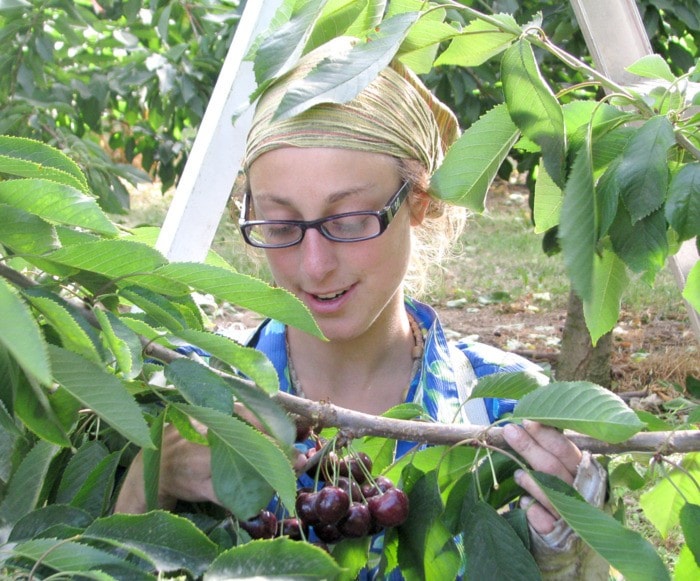Decent crop, lousy market. That has been the sentiment of local late season cherry growers in the last week.
After a miserably cool and wet spring, warm weather in late July and August has helped produce a fair to good quality crop of Lapins, Staccatoes, Sweethearts and other late season varieties. But a flood of Washington fruit into international and Canadian markets has dropped prices to levels that could be unprofitable, according to Erickson growers Rick and Jenny Faynor.
“A huge shipment of Washington cherries arrived in Europe to be sold on consignment in the last few days and prices have dropped like a rock,” Jenny said last Thursday. “The Washington crop is later than normal, just like ours.”
For smaller growers (compared to Washington, the Creston Valley has no large producers) and packers like the Faynors, lack of cold storage facilities means the cherries have to shipped immediately, forcing them to accept low market prices.
“There are cold storage facilities in Washington that are as large as our rec centre,” Rick said. “They are full and can be shipped as the market demands.”
The heavy rains and winds in July that wiped out about half of the early cherry crop (which isn’t as large or potentially lucrative as the late season one) also had an effect on Lapins, the first of the late season varieties. Rick said he is taking more than three tons a day to the landfill because there is no market for culled cherries. But later varieties are in good shape and should remain so if the weather remains warm and dry.
Poor spring and early spring weather affected other crops, too.
“There are no apricots this year,” Rick said.
In the orchards, the predominantly French-Canadian pickers seemed as cheerful as ever. A half dozen men and women were busy picking Don and Susan Low’s Lapin cherries on Erickson Road. The fruit was large and clean, largely unaffected by the rains because the trees are tented with fabric as the fruit begins to ripen.
Many of the migrant workers arrived after working on the poorer than usual Okanagan crop, happy to have work and glad to be back in the Creston Valley.
“This is the best place,” one commented. “And Don and Sue are the best.”
“Sue is so nice,” said Jessica Arseneau. “She makes awesome muffins and baking for our snacks.”
Rick Faynor said the migrant workers are treated very well by Creston Valley fruit growers.
“We work hard to keep the bad ones out, so the ones we hire are really good and they are grateful to be able to work in Creston,” he said.
Gary and Susan Snow have been working for the last several years to reduce their reliance on the late season cherry market and to find a use for the tons of culled cherries that have traditionally gone back onto their land as fertilizer, or to the landfill. Last year, they produced their first batch of Tabletree black cherry juice using a process that results in a product that has grabbed at attention around the continent.
“We are tripling production this year, but that’s not nearly where we want to be,” Susan said on Monday. “We had hoped to build a new, larger facility this year but by the time we got the financing in place we were too late to get it going.”
Making a value-added product on site gives the Snows a use for the culled cherries that a very fussy market won’t except. Pointing to boxes of culls waiting to be juiced, she said the global market can be frustrating.
“These are beautiful, tasty cherries, but if there is any marking at all on the skins they have to be culled,” she said. “The stems have to be on the cherries and the stems have to be green, too.”
Like most local cherry growers this year, the Snows found their Lapins to be unusually soft. Staccatoes and Sweethearts, both later varieties, were better. Best of all, though, have been the Kootenay Specials, a variety developed by Susan’s brother, Bill Truscott, and their father, Lew.
“The Kootenay Specials have that firmness that gives them a nice crunch when you bite into them, and they taste wonderful,” she said.
The Tabletree juice and a reduction called Black Cherry Culinary Sauce offers the Snows another income stream, a much-needed option considering the first cherries shipped this season cost more to produce than they were paid.
Erickson grower Graham Gray, who also operates his own packing shed, said early prices were discouraging, but that they have picked up in the last few days. Much of his crop this year went into the Miami market. One shipment went to Holland.
“But we sold to the Overwaitea Foods chain this year for the first time,” he said on Monday. “That’s only the second time we’ve had sales in the Canadian market.”
Local growers are pretty well shut out of the Canadian market.
“U.S. growers send 35 per cent of what they produce into Canada — they drive the price right down,” he said.
Low prices and soft Lapins — “I think we were fooled by their colour — they didn’t turn a consistent dark red until several days after they were fully ripe so we should have picked earlier,” Gray said — aside, the 2011 result has been better than the 2009 season.
“We lost nothing but tons of money that year,” Gray said. “Prices were really low at the start of harvest and then heavy rains wiped out the rest of the crop. Last year bounced back a bit but we had a smaller crop.”
Like most growers who are in it for the long term, Graham adopts a next-year attitude when it comes to disappointing results.
“As long as you have a day job, you might be able to afford to keep farming,” he laughed.
